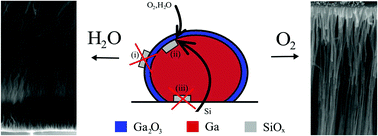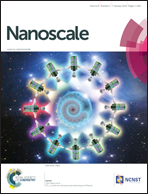Silicon oxide nanowire growth mechanisms revealed by real-time electron microscopy†
Abstract
Growth of one-dimensional materials is possible through numerous mechanisms that affect the nanowire structure and morphology. Here, we explain why a wide range of morphologies is observed when silicon oxide nanowires are grown on silicon substrates using liquid gallium catalyst droplets. We show that a gallium oxide overlayer is needed for nanowire nucleation at typical growth temperatures, and that it can decompose during growth and, hence, dramatically alter the nanowire morphology. Gallium oxide decomposition is attributed to etching caused by hydrogen that can be supplied by thermal dissociation of H2O (a common impurity). We show that H2O dissociation is catalyzed by silicon substrates at temperatures as low as 320 °C, identify the material supply pathways and processes that rate-limit nanowire growth under dry and wet atmospheres, and present a detailed growth model that explains contradictory results reported in prior studies. We also show that under wet atmospheres the Ga droplets can be mobile and promote nanowire growth as they traverse the silicon substrate.


 Please wait while we load your content...
Please wait while we load your content...